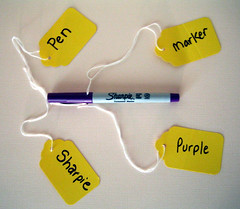#14 - I got a LibraryThing, you got a LibraryThing, everybody's got a LibraryThing
Are you a book lover or cataloger at heart? Do you enjoy finding lost and forgotten gems on the shelf to read?
If you answered 'yes' to either of the above questions, then LibraryThing may be the thing for you.
LibraryThing was developed by booklovers, for booklovers and its basic function is most excellent - it lets you quickly and painlessly create an online catalog of your personal book collection. And what makes it even more special is its social networking component - once you've entered your books, you get to see everyone elses via book titles, authors, and the tags you assign to each entry.
Yes, it's really that simple - you create an account and get to it. Add a book to your catalog with the title alone (it's so easy that you don’t even need to know what a MARC record is). And once you've got a title (or 2 or 200) you are able to connect to other users with similar reading tastes.
Let me illustrate - this link will take you to the Learning 2.0 account set up for this exercise (it will open in a separate window). If this takes you to the 'cover view,' look above the titles and click on 'list view.' From the 'list view,' look to the far right side of the screen - it shows you how many others have entered the title in question (the second number, by the way, is the # of 'pro' subscribers with the title). Think I'm the only one with enough time on my hands to read through 'Tintin: The Complete Companion?' Think again - its on the bookshelves of 60+ other Library Thing users.
You can also add a widget to display titles that are in your catalog or install a Library ThingSearch box on your blog or any other website you've set up (instructions are here).
So why join the ranks and create your own library online? With over 65,000 registered users (BTW: LibraryThing also has group forum for library staff) and 4.7 million catalog books, you are bound to discover something new.
Me? I'm still hoping to find more Dexy's Midnight Runners fans...
A quick, really quick, tour
The last thing before today's Discovery Exercise is the Library Thing tour. Take a quick run through these seven or eight screens for an overview of key Library Thing features and functions.
Now to the Discovery Exercise.
- Take a look around LibraryThing and create an account.
- Add a least 5 books to your library.
- Blog about your findings and be sure to link to your LibraryThing catalog.
- Already have a LibraryThing account and want to try something new? Give Shelfari or GuruLib a try instead.
But, wait, want to read a really interesting but long blog posting? A LibraryThng creator compares their tagging to that in use on Amazon.com.
Next up: Wikis...


